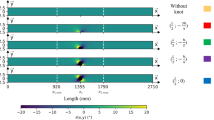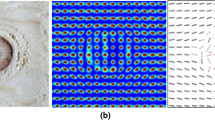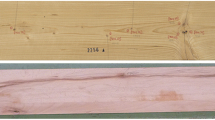Abstract
In the present paper, a model for the prediction of the local strength and stiffness properties is developed. Compared to existing models, here the local material properties are described according to their morphological characteristics; i.e. the timber boards are subdivided into sections containing knots (knot sections) and sections without knots (clear wood sections). The strains of the corresponding sections are measured during non-destructive tensile tests using an optical camera device. Based on these measurements the tensile stiffness of each particular section is estimated. For the estimation of the tensile strength, destructive tensile tests are performed. Herewith, the tensile strength of the entire timber board is measured. The strength of the other knot clusters are estimated using censored regression analysis. Taking into account the results of the experimental investigation, material models are developed to predict the tensile strength and the tensile stiffness of knot clusters.










Similar content being viewed by others
References
Benjamin JR, Cornell CA (1970) Probability, statistics and decisions in civil engineering. Mc Graw-Hill Book Company, New York
Blaß HJ, Frese M, Glos P, Denzler JK, Linenmann P, Ranta-Maunus A (2008) Zuverlässigkeit von Fichten-Brettschichtholz mit modifiziertem Aufbau, vol 11. KIT Scientific Publishing, Karlsruhe
Boatright SWJ, Garrett GG (1979a) The effect of knots on the fracture strength of wood i. a review of methods of assessment. Holzforschung 33(3):68–72
Boatright SWJ, Garrett GG (1979b) The effect of knots on the fracture strength of wood ii. a comparative study of methods of assessment, and comments on the application of fracture mechanics to structural timber. Holzforschung 33(3):72–77
Buckley J, James I (1979) Linear regression with censored data. Biometrika 66:429–36
CEN (2003) DIN EN 408, Timber structures, structural timber and glued laminated timber, determination of some physical and mechanical properties. German version
CEN (2009) DIN EN 14081-4, Timber structures, strength graded structural timber with rectangular crosssection Part 4: Machine grading Grading machine settings for machine controlled systems. German version
CEN (2010) DIN EN 384, Structural timber, Determination of characteristic values of mechanical properties and density. German version EN 384:2010
Chatterjee S, McLeich DL (1981) Fitting linear regression models to censored data by least squares and the method of maximum likelihood. Tech. rep., Department of statistics, Standford University
Courchene T, Lam F, Barrett J (1996) The effects of edge knots on the strength of spf msr lumber. In: Proceedings of the 29th Meeting, International Council for Research and Innovation in Building and Construction, Working Commission W18,Timber Structures, Bordeaux, France, CIB-W18, Paper No. 29-5-1
Denzler JK (2007) Modellierung des Grösseneffektes bei biegebeanspruchtem Fichtenschnittholz. PhD thesis, TU München
Ehlbeck J, Colling F, Görlacher R (1985) Einfluß keilgezinkter Lamellen auf die Biegefestigkeit von Brettschichtholzträgern Eingangsdaten für das Rechenmodel. Eur J Wood Prod 43(8):369–373
Faber M (2012) Statistics and probability theory: in pursuit of engineering decision support, vol 18. Springer, Berlin Heidelberg
Fewell A (1982) Machine stress grading of timber in the united kingdom. Holz Roh- Werkst 40(12):455–459
Fink G, Kohler J (2011) Multiscale variability of stiffness properties of timber boards. In: ICASP Applications of Statistics and Probability in Civil Engineering. Zurich, Switzerland
Fink G, Kohler J (2012) Zerstörungsfreie Versuche zur Ermittlung des Elastizitätsmodules von Holzbrettern. IBK Report No. 339, ETH Zürich, Zurich
Fink G, Deublein M, Kohler J (2011) Assessment of different knot-indicators to predict strength and stiffness properties of timber boards. In: Proceedings of the 44th Meeting, International Council for Research and Innovation in Building and Construction, Working Commission W18, Timber Structures, Alghero, Italy, CIB-W18, Paper No. 44-5-1
Giudiceandrea F (2005) Stress grading lumber by a combination of vibration stress waves and x-ray scanning. In: Proceedings of the 11th International Conference on Scanning Technology and Process optimization in the wood Industry (ScanTech 2005)., Las Veagas
Glos P (1978) Zur Bestimmung des Festigkeitsverhaltens von Brettschichtholz bei Druckbeanspruchung aus Werkstoff- und Einwirkungskenngrößen. Sonderforschungsbereich 96, Techn. Univ
Görlacher R (1990) Sortierung von Brettschichtholzlamellen nach DIN 4074 durch Messung von Longitudinalschwingungen. Bauingenieur 65:517–522
Görlacher (1984) Ein neues Messverfahren zur Bestimmung des Elastizitätsmoduls von Holz. Holz Roh- Werkst 42:219–222
Hastie T, Tibshirani R, Friedman J (2001) The elements of statistical learning, vol 1. Springer, Berlin Heidelberg
Heimeshoff B, Glos P (1980) Zugfestigkeit und Biege-E-Modul von Fichten-Brettlamellen. Eur J Wood Prod 38(2):51–59
Isaksson T (1999) Modelling the variability of bending strength in structural timber. PhD thesis, Lund Institute of Technology
Kline D, Woeste F, Bendtsen B (1986) Stochastic model for modulus of elasticity of lumber. Wood Fiber Sci 18:228–238
Köhler J (2006) Reliability of timber structures. Phd, ETH Zurich, reliability/Probability Theory
Köhler J, Sørensen JD, Faber MH (2007) Probabilistic modeling of timber structures. Struct saf 29(4):255–267
Kohler J, Brandner R, Thiel A, Schickhofer G (2013) Probabilistic characterisation of the length effect for parallel to the grain tensile strength of central european spruce. Eng Struct 56:691–697
Kollmann F, Krech H (1960) Dynamische Messung der elastischen Holzeigenschaften und der Dämpfung ein Beitrag zur zerstörungsfreien Werkstoffprüfung. Holz Roh- Werkst 18(2):41–54
Mitsuhashi K, Poussa M, Puttonen J (2008) Method for predicting tension capacity of sawn timber considering slope of grain around knots. J Wood Sci 54(3):189–195
Riberholt H, Madsen PH (1979) Strength of timber structures, measured variation of the cross sectional strength af structural lumber. Tech. rep., Struct. Research Lab., Technical University of Denmark
Samson M, Blanchet L (1992) Effect of knots on the flatwise bending stiffness of lumber members. Eur J Wood Prod 50(4):148–152
Sandomeer MK, Köhler J, Faber MH (2008) Probabilistic output control for structural timber, modelling approach. In: Proceedings of the 41th Meeting, International Council for Research and Innovation in Building and Construction, Working Commission W18 - Timber Structures, St. Andrews, Canada, CIB-W18, Paper No. 41-5-1
Steiger R (1996) Mechanische Eigenschaften von Schweizer Fichten-Bauholz bei Biege-, Zug-, Druck und kombinierter M/N-Beanspruchung-Sortierung von Rund- und Schnittholz mittels Ultraschall. PhD thesis, ETH Zurich
Taylor SE, Bender DA (1991) Stochastic model for localized tensile strength and modulus of elasticity in lumber. Wood Fiber Sci 23 (Number 4):501–519
Author information
Authors and Affiliations
Corresponding author
Rights and permissions
About this article
Cite this article
Fink, G., Kohler, J. Model for the prediction of the tensile strength and tensile stiffness of knot clusters within structural timber. Eur. J. Wood Prod. 72, 331–341 (2014). https://doi.org/10.1007/s00107-014-0781-0
Received:
Published:
Issue Date:
DOI: https://doi.org/10.1007/s00107-014-0781-0




